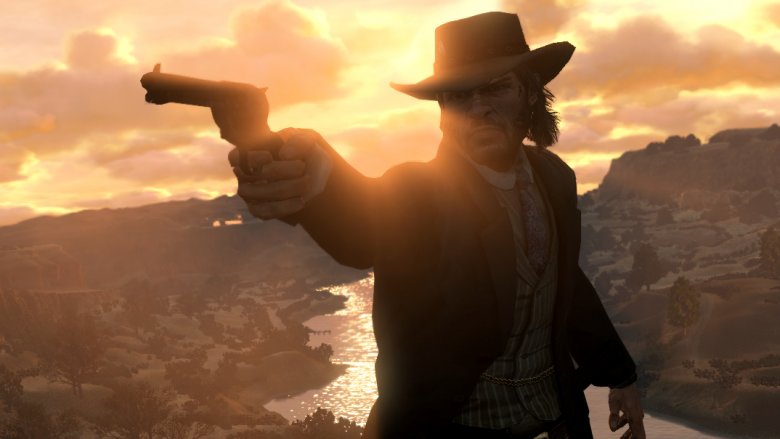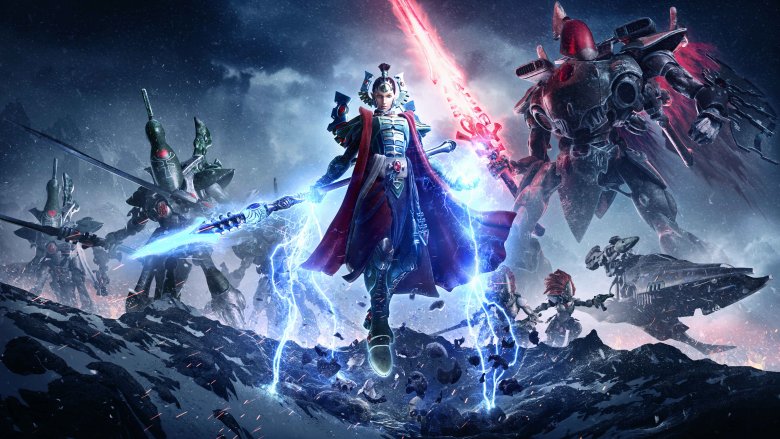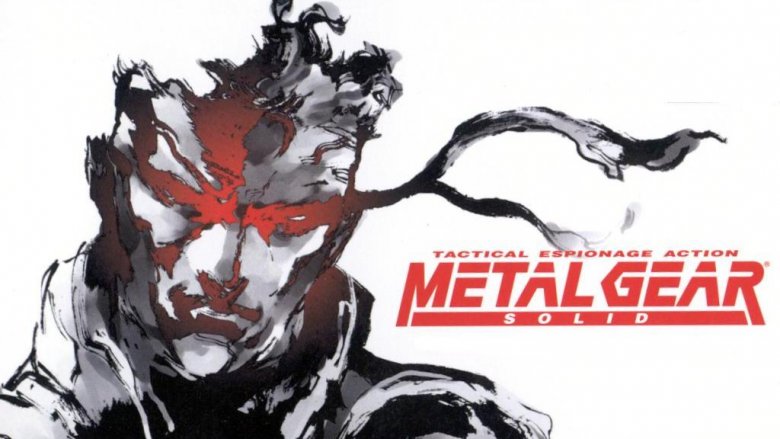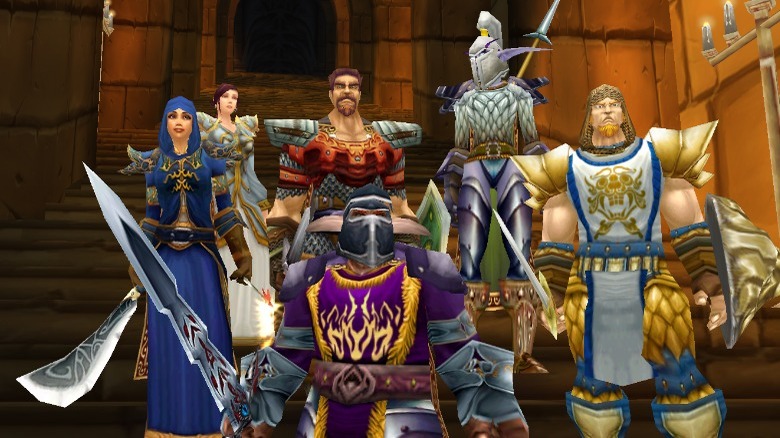Game Sequels That Were Nothing Like The Original
The video game industry thrives on sequels; there is almost no commercially successful game that hasn't been followed up, remade, or spun off in some way. Something about the series, whether it be its mechanics, its story, or even its vibe, is so appealing that it warrants multiple entries. Sometimes a franchise can even survive for several decades, despite evolving trends and expectations.
But every once in a while, a sequel comes along that isn't just an expansion on the previous game's ideas. Something profound changes, a fundamental shift in the whole experience. A change in scope, or genre, or tone so large, it almost feels like another game or another franchise altogether. In fact, some franchises have never been the same twice, but have reinvented themselves with every entry. While tacking so hard from a successful original game is unquestionably a risk, sometimes the result is so exceptional that the franchise is reborn in a bold new direction. Here are some game sequels that were nothing like the original.
Grand Theft Auto III
People forget, but in the beginning Grand Theft Auto was a ho-hum top-down 2D driving game. There was next to nothing in the way of story, and the tone, while anarchic, was nothing to write home about. Sure, the character technically went on some quests, but they were simple affairs and all more or less copies of each other. Steal cars, drive around, shoot people: rinse, repeat. All with a constantly swaying camera that made players, well, carsick. Even in the late '90s, when the game released, it felt like a title from yesteryear. The sequel, Grand Theft Auto 2 in 1999, did little to change up the formula.
So what did Grand Theft Auto III change just two years later? In a word: everything. GTA3 took the series into the third dimension. Its representation of New York City, called Liberty City, was a living, breathing world filled with characters to interact with. The story was deep and complex, by turns funny and serious, telling a crime story of both personal and epic proportions. And most importantly, every last inch of the game world oozed with atmosphere: satirical, over-the-top, and endlessly entertaining.
GTA3 looked, sounded, and felt nothing like the previous games. If Rockstar had wanted to, they could easily have called it by another name altogether. But perhaps that sense of criminal exultation was strong enough in all the Grand Theft Auto games to keep them under the same franchise roof; or maybe Rockstar just wanted to coast off whatever success the original games had enjoyed. Whatever the reason, Grand Theft Auto today still draws its influence from the third game in the series, whose formula was so good, it creates mega-sellers over fifteen years later.
Assassin's Creed II
The first Assassin's Creed game in 2007 was a bold experiment: could a game be both historically accurate and yet speculative, open yet directed, action-packed yet thought-provoking? The answer, apparently, was mixed. On release, Assassin's Creed looked stunning and allowed for a level of free mobility that other games only dreamed of. The story was intricate and unique, and the look and style of the Assassin Order was instantly iconic. And the ability to see an entire ancient city wake up and go about their lives was unprecedented in its detail.
Also, it was boring.
Critics ripped the game for being mind-numbingly repetitive. The experience is effectively a sequence of assassinations the player must carry out, but every single one follows the exact same pattern: complete a number of quests to gather information about the target, then go kill him. Other than some collectibles to find, there wasn't much else to actually do in the game. A title that promised to let players plan their missions their own way ended up being a hand-holding exercise in redundancy.
But unlike the assassin's targets, the franchise didn't die there. Developer Ubisoft Montreal came back two years later with Assassin's Creed II, which became a textbook example of keeping everything that worked about the original and tossing the rest. While the fully-realized cities and the free movement were still intact, Assassin's Creed II featured a dizzyingly large main storyline filled with unique and inventive missions that never repeated themselves. Critics were stunned by the sheer scale of Ubisoft's rescue operation, and equally by how well it worked. The franchise has followed in the sequel's footsteps ever since.
Dawn of War Franchise
When it debuted in 2004, Dawn of War was a good if not terribly original real-time strategy game. Based on the popular Warhammer 40,000 story universe, the game let you take the role of a battlefield commander. You'd collect resources, construct buildings, and recruit units, exactly as the RTS genre had done since Dune II in 1992. It was a commercial and critical success, and a hit in the broader Warhammer community. Sounds like a game ripe for a sequel! And it was!
Well, sort of. Dawn of War II indeed arrived in 2009, but to everyone's surprise, it wasn't an RTS at all. Gone were any kind of resource collection, base-building, or in-match unit recruitment. Instead, the you were less of a general and more of a squad leader, directing a small force of powerful characters. Tactics and intelligent positioning would win the day here, not resource management or macroeconomics. Though it continued the story and characters from the original game, the actual gameplay might as well have come from another planet. Despite the changes to a winning formula, Dawn of War II was another critical and commercial success.
So did Dawn of War III, which came in 2017, follow in the original game's footsteps, or the sequel's? The answer was: both! And also, neither! Dawn of War 3 tried to blend the powerful characters of the second game with the resource management and base-building of the first, while also throwing in some MOBA elements.
Which is all to say, if they ever announce a Dawn of War IV, no one will have any idea what genre it is.
Metal Gear Solid
Metal Gear released for the MSX computer platform in 1987. A top-down 2D action title in the vein of popular arcade games of the era, it featured a rugged but stealthy hero named Solid Snake sneaking into a fortified enemy compound. "Stealthy" being the key word here: unlike most other games, which were action bonanzas, Metal Gear asked players to exercise patience and restraint as they navigated guard patrol patterns and timed security measures.
The sequel, Metal Gear 2, followed the exact same style. But it was the third game, 1998's Metal Gear Solid, that changed the franchise forever. First, the game jumped from 2D to 3D, drenching the environment with a level of realism and detail that earlier titles could only dream of. But more importantly, the heroes transformed from thin sprites into became fully-voiced characters with depth, humanity, and moral and emotional complexity. Metal Gear Solid rejected the notion that gamers didn't care about story, and offered an involved, layered, and challenging narrative. Meanwhile, its boss battles remain some of the most legendary enemy encounters in game history.
Ultimately, Metal Gear Solid took the atmosphere and sensibilities of the earlier Metal Gear games, and cranked them up to eleven, all while injecting new ideas and innovations. It's so famous, that many gamers aren't even aware that it wasn't the first title in the series. In fact, nearly all follow-up games have been called Metal Gear Solid, not Metal Gear. Metal Gear Solid was an enormous risk–and it worked.
Nidhogg 2
Nidhogg came out of nowhere in 2014, the gaming equivalent of a garage band demo tape. Armed with nothing but a pixelated art style straight out of the 8-bit era, it quickly swelled into an underground sensation. The secret sauce of the game was its inventive swordfighting mechanics and pitch-perfect balance. While a little dull when playing against the AI, the game sprang to ultra-competitive life once two players went head to head in its mulitplayer mode. Lo-fi yet crackling with passion, Nidhogg was into Nidhogg before Nidhogg was cool.
Nidhogg 2 in 2017 wasn't exactly big-budget, but it was clearly a more elaborate, and more expensive, affair than the first. The art sensibility went from 8-bit to 16-bit, and with it came a more detailed and colorful overall style. If you put a screenshot of each game side-by-side, you'd never think they were from the same franchise. The first Nidhogg was all about celebrating minimalism. And while Nidhogg 2 doesn't go for photorealism or anything, it's no longer a minimalist hero.
The same goes for the gameplay. Where the first game only had one weapon, the sword (not counting the character's deadly hands), Nidhogg 2 features a variety of different weapons that mix up the experience. The game is still considered fun and balanced, but the garage band ethos is simply no longer on the tape.
Red Dead Redemption
When Rockstar acquired Angel Studios in 2002, there was one game in particular that caught Rockstar's eye: a cowboy shooter. Released in 2004 as Red Dead Revolver, it was a fun if unfocused third-person shooter soaked in Western flavor. But Revolver, at the end of the day, didn't really feel like a Rockstar game, despite the fact that Angel Studios had been renamed to Rockstar San Diego after the acquisition. It wasn't a massive open-world experience, its story wasn't any more complicated than "get revenge," and it didn't bring the Wild West to life. It was just a fun romp in the tumbleweeds.
Revolver's sequel was a long time in coming, but Red Dead Redemption was at last released in 2010. And nobody complained that it wasn't a Rockstar game. Enormous open-world environments featuring deserts, mountains, and villages in equal measure? Check. Deep, complex, layered story with three-dimensional characters and sizzling dialogue? Check. The best representation of its setting in gaming history? Check and check again. Where Revolver was a linear shooter game, Red Dead Redemption was the closest thing to the Wild West since, well, the Wild West.
Redemption was such a rebirth for the franchise (indeed, the very name Redemption might refer to its impact on the Red Dead series) that its own follow-up is simply called Red Dead Redemption 2. Revolver has more or less been relegated to 'prologue' status in the franchise.
Call of Duty 4: Modern Warfare
The Call of Duty franchise was birthed when World War II shooters were the hottest genre in the industry. Steven Spielberg's Saving Private Ryan had rekindled interest in the time period, and few conflicts in history have been such ripe settings for action stories. Call of Duty and Call of Duty 2 expanded on where other World War II shooters had gone by involving not only the United States, but also Great Britain and Soviet Russia. The games were intense, with superbly tight controls and unrelenting combat. Activision would have been more than happy to get another game just like it.
But developer Infinity Ward had a crazy notion: they wanted to leave the Nazis behind and instead explore conflicts in the modern era, with all the technology and contemporary issues that entailed. The result was one of the most influential shooters of all time: Call of Duty 4: Modern Warfare.
But its influence extended beyond just shifting the default shooter setting from World War II to the modern day. Modern Warfare's multiplayer incorporated various elements formerly associated with RPGs, such as gaining experience, leveling up, gathering loot, and earning new abilities. This style of multiplayer blew away its competition and became the gold standard by which every other shooter was measured. Call of Duty 4 is a perfect example of knowing when to jump away from success in order to avoid stagnation...and achieve even greater success.
World of Warcraft
Warcraft was one of the seminal real-time strategy franchises, that helped to develop, refine, and popularize the entire genre. The Warcraft games also helped to propel its developer, Blizzard Entertainment, from just another game company into one of the industry's juggernauts. With the release of Warcraft III in 2002, Blizzard elevated the franchise to another level, incorporating elements from the popular Diablo series like hero units and items that enhanced them. Featuring a deep story with rich lore across four different factions, Warcraft III all but assured that the RTS franchise would continue on.
Except, it didn't. Instead, Blizzard made the bold decision to throw out everything Warcraft had ever been, and recast it as a massively mulitplayer online game, or MMO. The risk was obvious: Warcraft had always been an RTS, so would its fans care about controlling individual characters in a vast open world? Blizzard made a couple of bets: one, that players loved the world and narrative as much as the gameplay; and two, that Blizzard had the capacity to make a game good enough to draw players no matter the genre.
Did it work? Well, you could ask any of the millions of players who paid a subscription fee to World of Warcraft every month. Or, you could just go swimming in the giant pool of money that World of Warcraft made for Blizzard. World of Warcraft might not have played like any of the earlier games, but it still had all the charm, epic scope, and beautiful art design of its predecessors. Totally different, but still the same: welcome to the world of Warcraft.
The Legend of Zelda franchise
The Legend of Zelda is one of the longest-running, best-selling, and most-beloved franchises in the entire medium. The brainchild of gaming guru Shigeru Miyamoto, Zelda is a flawless blend of exploration, combat, and fairy-tale fantasy. Its story of a bright, optimistic hero on a noble quest to save his lady love is timeless and works across every culture.
And yet, for all of the many titles in the series, every individual game stands alone. Because The Legend of Zelda isn't one long, overarching narrative: it's a variation on a theme. In every game, our hero Link is initially outmatched by his opponent; in every game, Link's lady Zelda is kidnapped; and in every game, Link traverses a completely different world, because Hyrule never really looks the same way twice.
Some fans (and even Nintendo) have tried to construct elaborate theories that tie all the games into a single chronology, but really, this misses the point. That very first Legend of Zelda gave players an adventure with personality and energy unlike anything else out there. Instead of getting distracted by a continuing narrative, Nintendo and Miyamoto instead chose to recapture the adventure itself. If the joy of discovery was essential to the appeal, why not let gamers discover each game anew, every time?
Lightning could strike twice, or twelve times, if the lightning was all the developers focused on. It's still striking today.
Final Fantasy Franchise
There aren't many franchises that tower over the landscape like Final Fantasy. One of the most important Japanese role-playing game (JRPG) series, Final Fantasy has reliably delivered blockbuster hits for over thirty years. Its freewheeling blend of science-fiction and fantasy sets it apart from nearly any other story universe on the market. Except for one thing: Final Fantasy doesn't have a story universe.
Final Fantasy is one of the very few anthology franchises in gaming, meaning that every single game takes place in a different universe with different characters, magic, and lore. Where The Legend of Zelda always varies around the same elements, Final Fantasy is free to explore whatever wild ideas its developers cook up. Even when the series produces a generation-defining masterpiece, such as Final Fantasy VII, Squaresoft (later Square Enix) has always had the courage to avoid making a straight follow-up. No matter what, Final Fantasy stays true to its anthology nature.
That said, particularly successful entries do get some extra attention. The aforementioned Final Fantasy VII has produced an animated film and will soon be remastered. Meanwhile, Final Fantasy X actually got a straight sequel, though this was called–bizarrely–Final Fantasy X-2 and not Final Fantasy XI. But that right there is the whole point: Final Fantasy XI was an entirely new game and an entirely new experience. The franchise will never repeat itself in a full-numbered release, but always push in yet another new direction. Clearly there's nothing final about this fantasy.




